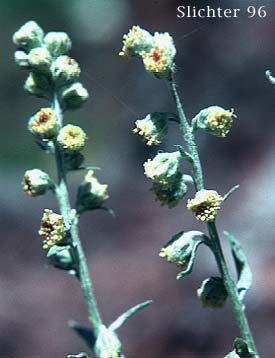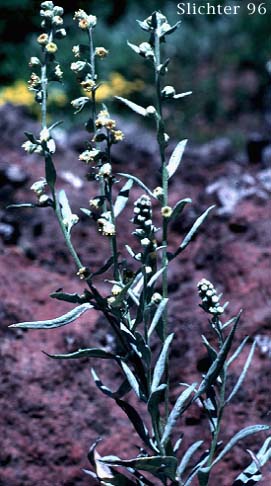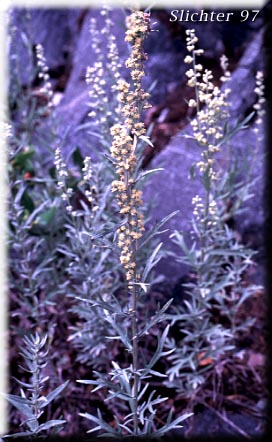
Western Wormwood
Artemisia ludoviciana

 Photo at right of Artemisia ludoviciana.........July 14, 1990.
Photo at right of Artemisia ludoviciana.........July 14, 1990.
Western wormwood is an upright, aromatic herbaceous plant with numerous flower heads clustered close to the upper part of the main stem. The stems arise 30-200 cm high from the base. The herbage consists of dense, white-tomentose hairs. The leaves are numerous on the stems. They are lanceolate or lance-elliptic in shape with entier to deeply lobed margins. Any leaf lobes that are present may again be further lobed or toothed. The leaves range from 3-11 cm long and up to 1 cm wide (on blades with entire margins).
The flower heads are discoid, with 6-45 yellowish disk flowers, depending on the variety. The leaves are entire to deeply parted or divided. The plants are somewhat silver haired. Plants flower from July into October.
Gray Sagewort: Artemisia ludoviciana ssp. candicans (Synonym: Artemisia ludoviciana var. latifloba) -
Estes's Artemisia: Artemisia ludoviciana ssp. estesii -
Intermediate Sagewort, Prairie Sage, Western Mugwort: Artemisia ludoviciana ssp. incompta (Synonym: Artemisia ludoviciana var. incompta) -
Columbia River Sagewort, Columbia River Wormwood, Riverbank Wormwood: Artemisia ludoviciana ssp. lindleyana (Synonyms: Artemisia lindleyana, Artemisia prescottiana)
Louisiana sagewort, Silver Wormwood: Artemisia ludoviciana ssp. ludoviciana (Synonyms: Artemisia diversifolia, Artemisia gnaphaloides, Artemisia ludoviciana var. ludoviciana, Artemisia vulgaris var. ludoviciana) -
Dry open places.
Range:
Western wormwood is found mostly east of the Cascades and Sierra Nevada, but is otherwise common in the western United States.

Photo above of western wormwood along the Chief Joseph Trail, Wallowa-Whitman N.F..........July 27, 1997.